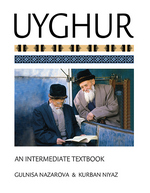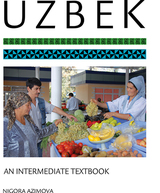
Dari: An Intermediate Textbook, designed to cover one year of instruction, offers beginning learners a communicative approach to learning Dari in a cultural context
Suitable for students and professionals alike, Dari: An Intermediate Textbook offers a thematically-organized approach to learning the Dari language with task-oriented, communicative activities that develop the four primary language skills—speaking, listening, reading, and writing. Incorporating the latest innovations in foreign language teaching and pedagogy, this textbook enhances learners’ ability to communicate successfully with Dari speakers and more fully engage with a rich and vibrant culture. Dari: An Intermediate Textbook prepares learners to perform at level 2 or 2+ on the ILR scale and at the Intermediate High to Advanced Low levels on the ACTFL scale.
Features include:-Videos filmed in the different regions of Afghanistan and audio by native speakers (available to stream for free on the Press website)-Abundant cultural notes on Afghan society, customs, and nonverbal aspects of communication, such as body language and gestures-A functional approach to grammar with explanations presented in both written and spoken contexts to facilitate practice in both modalities-Additional notes for people with experience in Persian to help them learn Dari more efficiently-Chapter themes that facilitate understanding of Afghan daily life and culture

Designated a critical language by the US Department of Defense, Pashto is one of the two official languages of Afghanistan and is commonly spoken in parts of Pakistan. This intermediate-level textbook, which follows Pashto: An Elementary Textbook, Volumes 1 and 2, is designed to bring students from high-introductory to intermediate proficiency. It offers students with basic knowledge of Pashto a thematically organized approach that develops strong speaking, listening, reading, and writing skills in the language used in everyday life and in official communications, the mass media, and the educational system of Afghanistan.
Utilizing current innovations in foreign language teaching, Pashto: An Intermediate Textbook is an invaluable resource for professionals and students wishing to improve their proficiency in this critical language.
Features of Pashto: An Intermediate Textbook:• More than a hundred audio files, available to stream on the Press website. Vocabulary lists allow readers to hover over a written word or phrase and hear it in both eastern and western dialects.• Carefully selected themes, including practical situations in survival and rich descriptions of the Pashtun code of honor and wedding customs, in order to help students learn the language within its cultural context.• Grammar points that help students quickly master the essential function of the structural elements used in the texts.• Pashto-English and English-Pashto glossaries that provide information regarding the gender and number of nouns, adjectives, and various forms of verbs.• Attractive four-color, user-friendly design with integrated audio and written exercises and cultural notes to provide students with necessary background.

Uyghur: An Intermediate Textbook offers students, professionals, and travelers alike the preeminent tool for expanding their knowledge of the Uyghur language and culture. Combining innovative language learning methodology with authentic audio and video materials, this textbook develops the four primary language skills—speaking, listening, reading, and writing—by integrating them into a clear, balanced whole.
Uyghur: An Intermediate Textbook prepares learners to perform at level 1+/2 or 2+ on the ILR scale and at the Intermediate High to Advanced Mid/High levels on the ACTFL scale.
Features include:
* A multimedia CD that contains videos filmed on location as well as both authentic and scripted audio segments, all highlighting key elements of Uyghur culture
* Authentic original and modified reading passages ranging from short stories to news articles to menus
* Abundant cultural notes to reinforce reading, grammar, and vocabulary skills
* Easy-to-understand examples and exercises on points of Uyghur grammar
* Chapter themes that facilitate immersion in daily Uyghur life and culture
Designed for both classroom and on-the-ground learners, and developed in accordance with the latest ideas in performance-based principles and methodology, Uyghur: An Intermediate Textbook guides readers on a journey to the heart of a fascinating culture.

Using a wide selection of materials and task-oriented activities drawn from realistic situations and contexts, Uzbek: An Intermediate Textbook, is designed to help adult professional and higher education learners deepen their understanding of the Uzbek language, culture, and its people. Learners will develop listening, reading, speaking, and writing skills, with special attention to grammatical accuracy. With a variety of texts, audio clips, videos, and activities, this textbook will encourage learners to explore Uzbek culture and to compare and contrast it with their own.
Uzbek: An Intermediate Textbook prepares learners to perform at level 1+ or 2 on the ILR scale and at the Intermediate High or Advanced Low level on the ACTFL scale.
Features of Uzbek: An Intermediate Textbook:-Topics covered include work, study, personal interests, and travel.-Authentic audio and video materials to accompany the text, available for free on GUPTextbooks.com-The book uses the Cyrillic alphabet—the alphabet used in current government reports and the mass media as well as in archival material from the Soviet era.-A useful appendix compares the Cyrillic alphabet with the Latin alphabet.-Uzbek-English and English-Uzbek glossaries facilitate vocabulary acquisition.
READERS
Browse our collection.
PUBLISHERS
See BiblioVault's publisher services.
STUDENT SERVICES
Files for college accessibility offices.
UChicago Accessibility Resources
home | accessibility | search | about | contact us
BiblioVault ® 2001 - 2024
The University of Chicago Press









